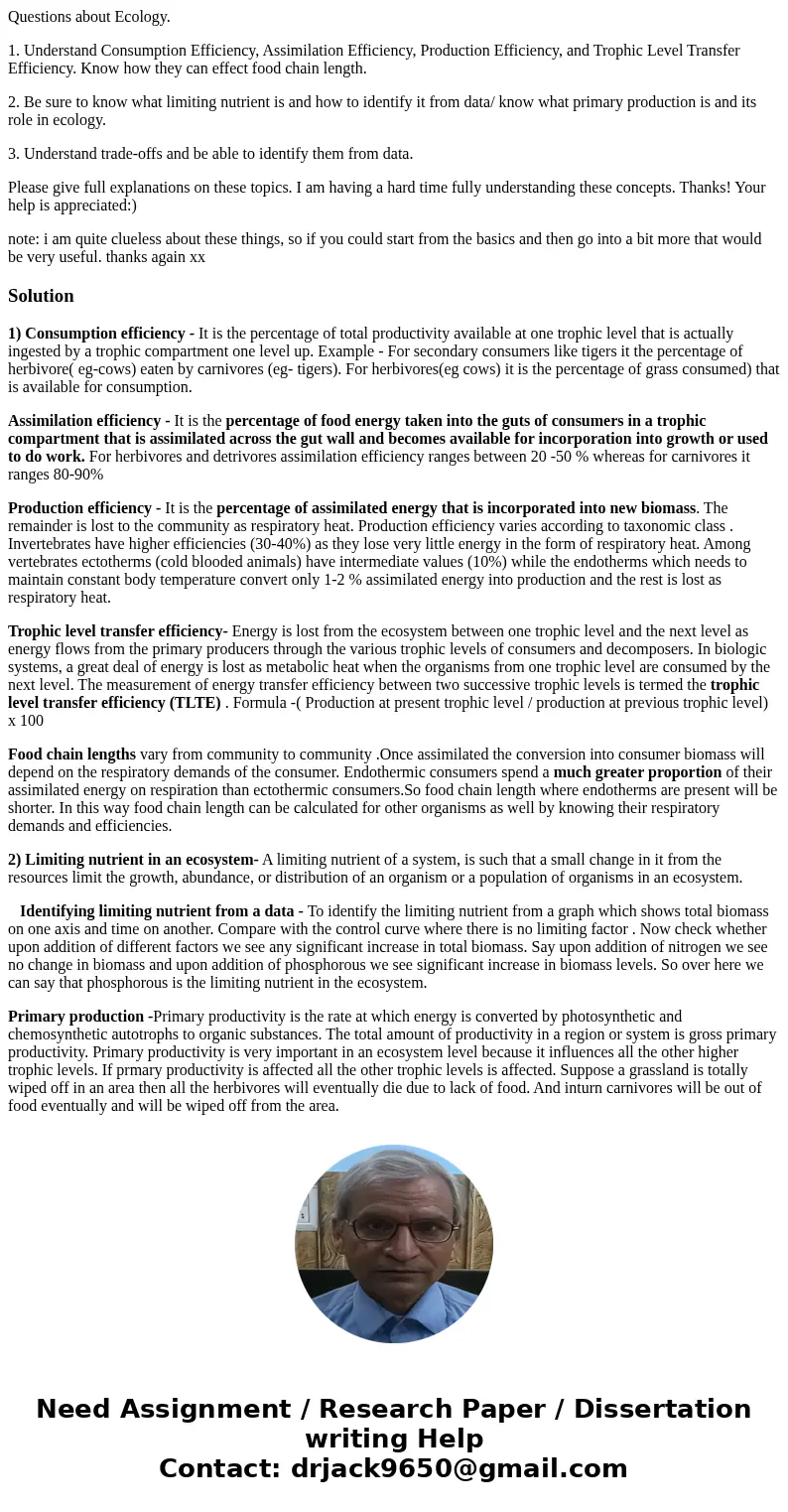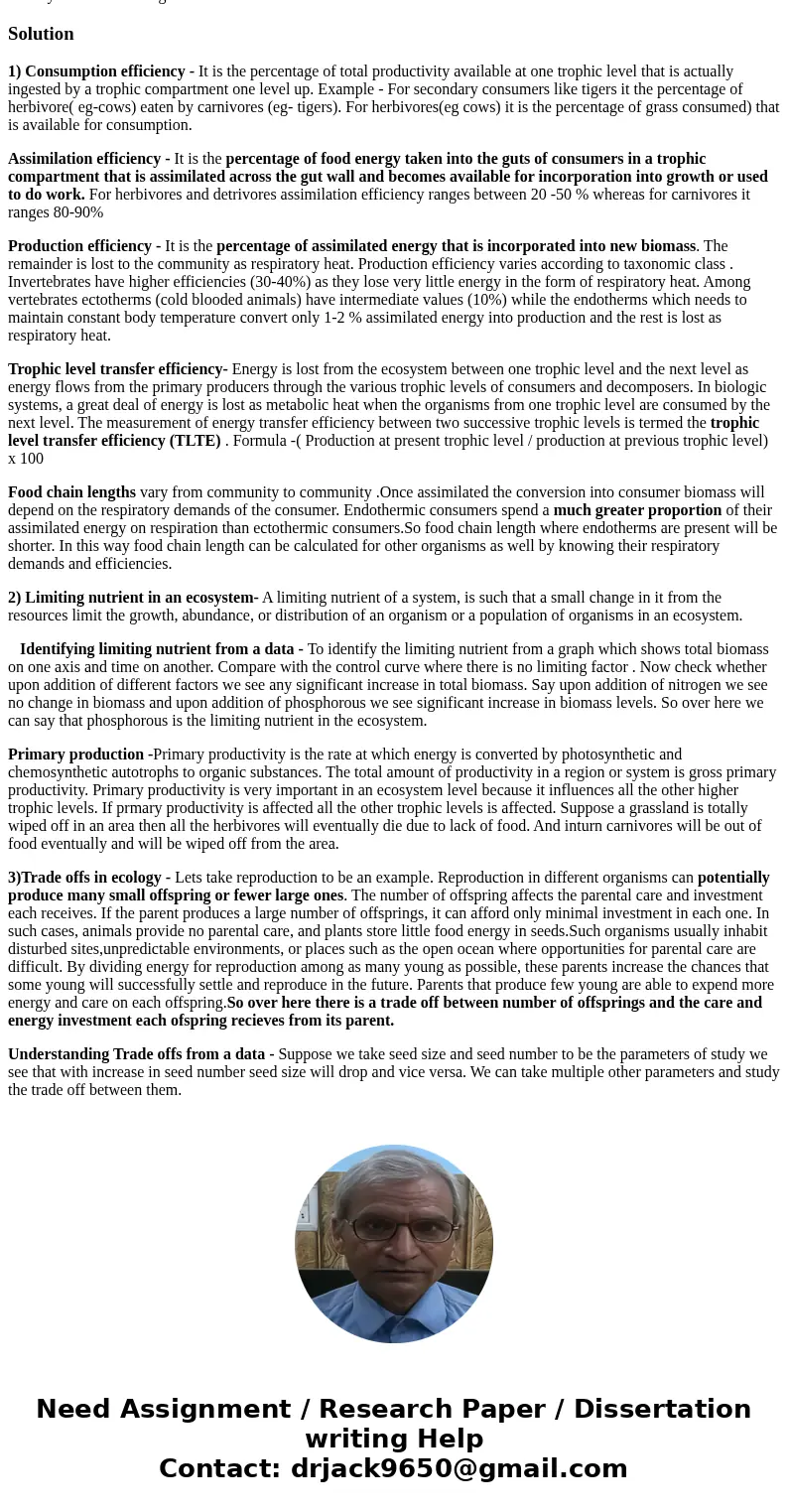Questions about Ecology 1 Understand Consumption Efficiency
Questions about Ecology.
1. Understand Consumption Efficiency, Assimilation Efficiency, Production Efficiency, and Trophic Level Transfer Efficiency. Know how they can effect food chain length.
2. Be sure to know what limiting nutrient is and how to identify it from data/ know what primary production is and its role in ecology.
3. Understand trade-offs and be able to identify them from data.
Please give full explanations on these topics. I am having a hard time fully understanding these concepts. Thanks! Your help is appreciated:)
note: i am quite clueless about these things, so if you could start from the basics and then go into a bit more that would be very useful. thanks again xx
Solution
1) Consumption efficiency - It is the percentage of total productivity available at one trophic level that is actually ingested by a trophic compartment one level up. Example - For secondary consumers like tigers it the percentage of herbivore( eg-cows) eaten by carnivores (eg- tigers). For herbivores(eg cows) it is the percentage of grass consumed) that is available for consumption.
Assimilation efficiency - It is the percentage of food energy taken into the guts of consumers in a trophic compartment that is assimilated across the gut wall and becomes available for incorporation into growth or used to do work. For herbivores and detrivores assimilation efficiency ranges between 20 -50 % whereas for carnivores it ranges 80-90%
Production efficiency - It is the percentage of assimilated energy that is incorporated into new biomass. The remainder is lost to the community as respiratory heat. Production efficiency varies according to taxonomic class . Invertebrates have higher efficiencies (30-40%) as they lose very little energy in the form of respiratory heat. Among vertebrates ectotherms (cold blooded animals) have intermediate values (10%) while the endotherms which needs to maintain constant body temperature convert only 1-2 % assimilated energy into production and the rest is lost as respiratory heat.
Trophic level transfer efficiency- Energy is lost from the ecosystem between one trophic level and the next level as energy flows from the primary producers through the various trophic levels of consumers and decomposers. In biologic systems, a great deal of energy is lost as metabolic heat when the organisms from one trophic level are consumed by the next level. The measurement of energy transfer efficiency between two successive trophic levels is termed the trophic level transfer efficiency (TLTE) . Formula -( Production at present trophic level / production at previous trophic level) x 100
Food chain lengths vary from community to community .Once assimilated the conversion into consumer biomass will depend on the respiratory demands of the consumer. Endothermic consumers spend a much greater proportion of their assimilated energy on respiration than ectothermic consumers.So food chain length where endotherms are present will be shorter. In this way food chain length can be calculated for other organisms as well by knowing their respiratory demands and efficiencies.
2) Limiting nutrient in an ecosystem- A limiting nutrient of a system, is such that a small change in it from the resources limit the growth, abundance, or distribution of an organism or a population of organisms in an ecosystem.
Identifying limiting nutrient from a data - To identify the limiting nutrient from a graph which shows total biomass on one axis and time on another. Compare with the control curve where there is no limiting factor . Now check whether upon addition of different factors we see any significant increase in total biomass. Say upon addition of nitrogen we see no change in biomass and upon addition of phosphorous we see significant increase in biomass levels. So over here we can say that phosphorous is the limiting nutrient in the ecosystem.
Primary production -Primary productivity is the rate at which energy is converted by photosynthetic and chemosynthetic autotrophs to organic substances. The total amount of productivity in a region or system is gross primary productivity. Primary productivity is very important in an ecosystem level because it influences all the other higher trophic levels. If prmary productivity is affected all the other trophic levels is affected. Suppose a grassland is totally wiped off in an area then all the herbivores will eventually die due to lack of food. And inturn carnivores will be out of food eventually and will be wiped off from the area.
3)Trade offs in ecology - Lets take reproduction to be an example. Reproduction in different organisms can potentially produce many small offspring or fewer large ones. The number of offspring affects the parental care and investment each receives. If the parent produces a large number of offsprings, it can afford only minimal investment in each one. In such cases, animals provide no parental care, and plants store little food energy in seeds.Such organisms usually inhabit disturbed sites,unpredictable environments, or places such as the open ocean where opportunities for parental care are difficult. By dividing energy for reproduction among as many young as possible, these parents increase the chances that some young will successfully settle and reproduce in the future. Parents that produce few young are able to expend more energy and care on each offspring.So over here there is a trade off between number of offsprings and the care and energy investment each ofspring recieves from its parent.
Understanding Trade offs from a data - Suppose we take seed size and seed number to be the parameters of study we see that with increase in seed number seed size will drop and vice versa. We can take multiple other parameters and study the trade off between them.


 Homework Sourse
Homework Sourse